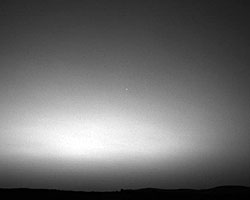
Constellations appear as friendly reminders that the nine planets share the same star fields. But they also teach astronomers about nighttime cloud cover and cloud composition. This image, which shows Orion's belt and the northern part of the constellation, has been artificially brightened.
Courtesy NASA / JPL / Cornell University.
Since their arrival on the red planet, the Mars Exploration Rovers have sent back thousands of breathtaking pictures of the ruddy landscape. The rovers are doing much more than analyzing rocks and looking for water. Michael Wolff (Planetary Science Institute), Michael Smith (NASA/Goddard Space Flight Center), and others have been using Spirit and Opportunity to learn as much as they can about Mars's atmosphere and weather.
The world got its first glimpse of what happens when the rovers "look up" when NASA released Opportunity's panoramic camera (Pancam) images of Phobos and Deimos moving in front of the Sun. The predicted timings of the passages were a tad bit off, causing astronomers to slightly refine their assumed orbits of the tiny Martian moons. While having little other scientific value, the images highlight the power of Pancam for studying astronomical phenomena from Mars.

Opportunity's Mini-TES instrument was recently pointed up at the exact same time that the Thermal Emission Spectrometer (TES) aboard Mars Global Surveyor was pointing down. TES could not accurately measure temperatures close to the ground, and Mini-TES couldn't look higher than about 6 kilometers. But together, they provide the first accurate atmospheric temperature profile from the surface to space. Where the two instruments' data sets overlap (4 to 6 km), the match is striking.
Courtesy NASA / JPL / GSFC / ASU / Cornell University.
The workhorse instrument for atmospheric studies is the Miniature Thermal Emission Spectrometer (Mini-TES). Scientists are using it to study the thermal connection between the ground and the lower atmosphere. Orbiting spacecraft have difficulty measuring atmospheric temperatures all the way down to the surface because of errors introduced by atmospheric dust and residual heat from the ground. "When looking in the thermal infrared, we need a temperature contrast" to distinguish the Martian terrain, says Wolff. "The surface is like a light bulb."
Nailing down the temperature profile from the ground up is thus a critical step toward understanding how Martian weather systems work. To make these measurements, Mini-TES monitors air temperatures up to several kilometers high. It can even watch hot air rising from the surface and dispersing high above the ground.
An additional essential component to Martian weather is dust, and the rovers look for and characterize aerosols in the atmosphere with each upward observation. Detailing the interactions of aerosols with the atmosphere is a necessary parameter in any model predicting dust storms or other Martian weather. "We really don't know how dust storms form, regionally or globally," says Wolff.

Earth appears as a tiny white dot near the center of this picture, which is a mosaic of images taken by Spirit's Navigation Camera and Panoramic Camera. The contrast has been enhanced to make Earth easier to see.
Courtesy NASA / JPL / Cornell University.
Finally, the most obvious sign of weather, on Earth or Mars, comes from clouds. "Water-ice clouds and dust clouds have distinct signatures", says Wolff, and Mini-TES can simply look to the stars and determine what clouds, if any, are blocking its view. Watching how clouds develop and evolve, from day to night, and from season to season, will speak volumes toward understanding the Martian global climate.
 0
0
Comments
You must be logged in to post a comment.